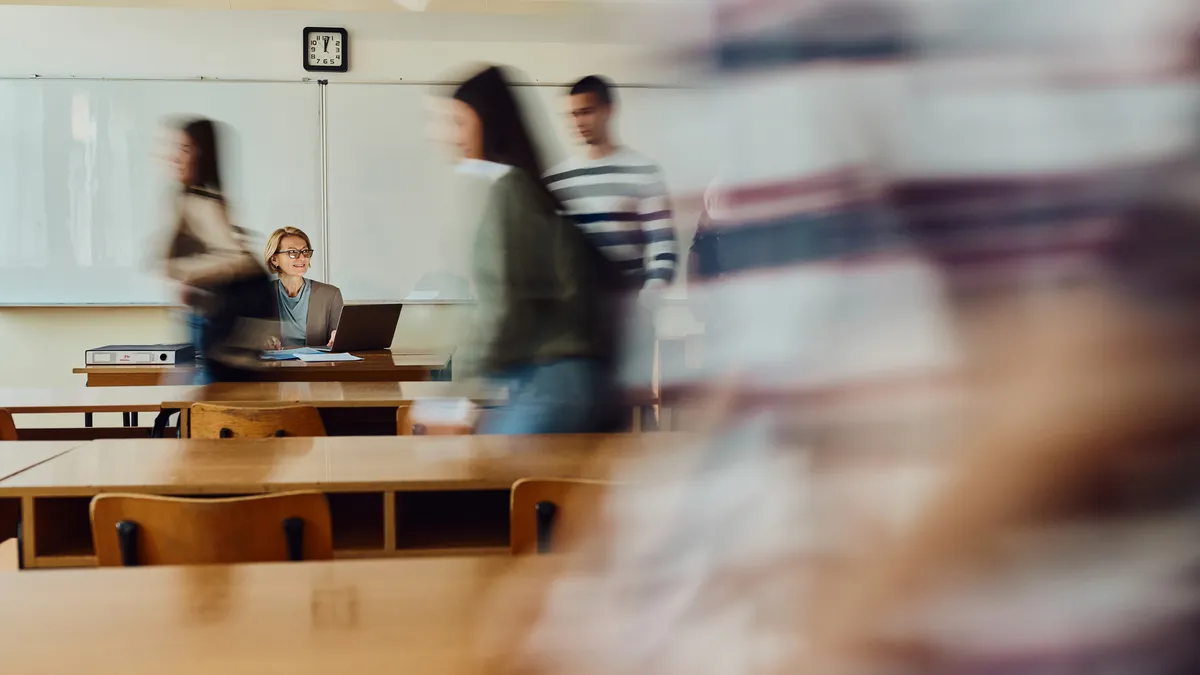Editor's note: In this column, we look ahead at how the coronavirus pandemic could affect aspects of higher ed in the long term.
As the coronavirus took hold in the U.S., colleges' disability services offices were busy helping with the rapid shift online. Often, they only had days to contact faculty members to confirm students with disabilities had what they needed to continue classes remotely.
Some of those tools or changes had never been tested in a classroom before, said Kristie Orr, director of Disability Resources at Texas A&M University and president of the Association on Higher Education and Disability (AHEAD).
Students with partial or full hearing loss might not have required a translation service in a small classroom, but now they needed their video lectures captioned.
Students who are blind might have their typical coursework translated into Braille, but now it also needed to be mailed to their home address.
The pandemic has forced colleges to be more flexible than ever before. Professionals who work with students with disabilities say they see room for some of this leeway to continue after the crisis subsides.
Disability services offices mostly ensure students' needs are met on campus, whether that be finding them a notetaker in class or making sure they live alone in a dormitory. While higher ed does not have the same legal responsibilities for students with disabilities as K-12 schools, they still must meet their needs under federal law. About one-fifth of undergraduates report having a disability, according to the latest federal data.
Moving the offices themselves online isn't much of a lift, Orr said, as many of their services were already available remotely. After the pandemic disrupted operations, her university created a webpage for students that outlines important elements of what disability services offers, including contact information to get help.
Improving online access
Ensuring virtual class materials and their websites are accessible to students with disabilities has proven challenging for some colleges, however.
Hundreds of institutions have been scrutinized by the U.S. Department of Education for not providing the appropriate level of online access. A battery of lawsuits, including some against Harvard University and the Massachusetts Institute of Technology, as well as settlements with the department, have forced many colleges to change their practices in recent years.
Institutions that haven't taken steps to improve accessibility might struggle with the current transition to distance learning, said Jamie Axelrod, director of Disability Resources at Northern Arizona University and the past president of AHEAD.
For instance, instructors might upload a photocopied PDF to the learning management system to supplement an online lecture. If they don't confirm whether screen readers can process the document, students with visual impairments may not be able to access the material.
These tools and services should promote equity as well, Axelrod said. A blind student on campus might work with a staff member who reads course materials to them. But if the student can only talk to that person for a few hours during the week, while their peers can do a class reading at any time of day, then it's not equitable, he said.
New kinds of testing
Some faculty have also resisted new ways of delivering classwork and exams for students with disabilities because doing so can require major changes to how they create a course.
The coronavirus has changed that. Instead of a timed, closed-book test, which can be challenging for some students with disabilities to prepare for and complete, more instructors are assigning a final essay or a more comprehensive exam that is completed over a couple of days using notes, said Amanda Kraus, executive director for Disability Resources and Housing and Residential Life at the University of Arizona.
Instructors are using these alternative capstones in lieu of traditional finals, which they can't easily monitor for cheating while remote, Kraus said.
Because these options can be time-consuming to deliver, instructors may not have offered them widely prior to the pandemic. By trying them now, Kraus said, instructors may be encouraged to keep using them after the crisis abates, even for students without disabilities.
Another reason they may be used more frequently going forward is that the way traditional exams are monitored in a remote setting isn't suited for students with disabilities.
These services, which have become more popular during the pandemic, use a person or software to monitor a student through their computer's webcam as they take a test. Some programs are trained to flag certain behaviors, such as when a student speaks out loud or frequently shifts their eyes away from the screen. Both of these are common for a student with disabilities, Axelrod said. Others ask students to log in by holding up an ID, something not all students can physically do, he said.
Some disability services experts also think students will have more options for how to tune into lectures.
Colleges are putting in online infrastructure now that lets students access lectures remotely, either through a livestream or a recorded video with captions. After the pandemic, those features could help students stay on top of their coursework if they have certain conditions that prevent them from attending classes during a flare-up of symptoms, Axelrod said.
But colleges have to be careful about what software they use, he said. Automated captioning services on YouTube and Zoom, the latter of which has seen a surge of activity during the pandemic, don't cut it because they are imperfect and often can't translate technical terms, Axelrod said. The words generally appear as a "stream of consciousness" on the screen, without discerning a speaker's pauses or inflections, he added. Captioning services must meet the standards of the Americans with Disabilities Act.
Implementing new accessibility measures will be more challenging for some colleges than others. Small liberal arts schools, where the faculty and administration have close ties, will be able to address a wide range of needs more quickly than flagship institutions, where a single lecture class might have more than 60 students, Kraus said.
"When you have to make big, fundamental shifts in operations, it may be hard to do at large, public schools," she said.



















